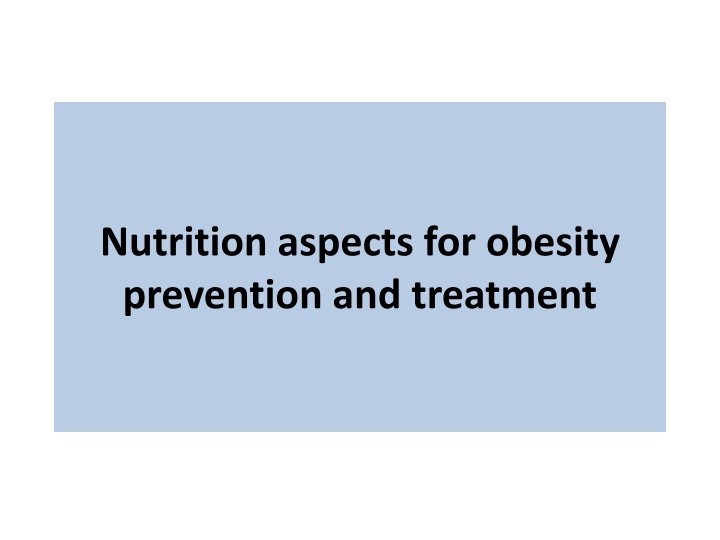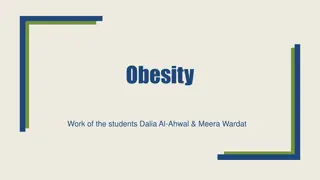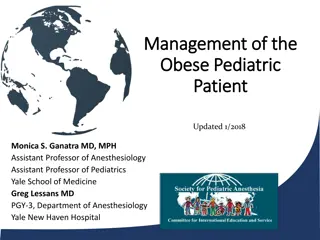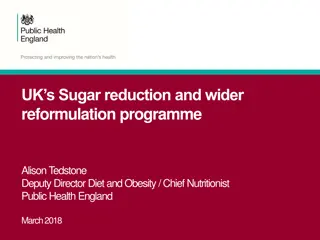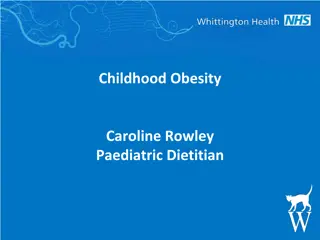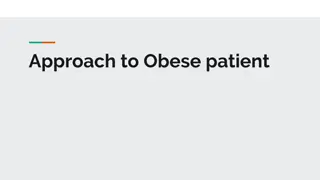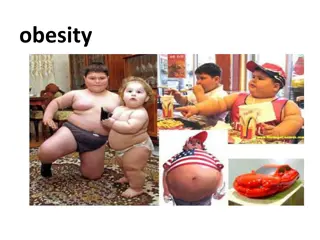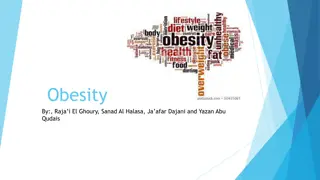Nutrition Aspects for Obesity Prevention and Treatment
Obesity is defined by abnormal fat accumulation, often measured by BMI. Nutrition aspects focus on AMDR for macronutrients like carbohydrates, proteins, and fats to reduce chronic disease risks. Understanding nutrient energy values is crucial for designing effective diet programs, including ketogenic diets, for obesity prevention and treatment.
Download Presentation

Please find below an Image/Link to download the presentation.
The content on the website is provided AS IS for your information and personal use only. It may not be sold, licensed, or shared on other websites without obtaining consent from the author.If you encounter any issues during the download, it is possible that the publisher has removed the file from their server.
You are allowed to download the files provided on this website for personal or commercial use, subject to the condition that they are used lawfully. All files are the property of their respective owners.
The content on the website is provided AS IS for your information and personal use only. It may not be sold, licensed, or shared on other websites without obtaining consent from the author.
E N D
Presentation Transcript
Nutrition aspects for obesity prevention and treatment
Objectives: 1- Obesity definition and classification. 2- Specific terms in nutrition aspects. 3- Nutrition aspects for obesity prevention and treatment 4- Diet programs. 5- Ketogenic diet program
Obesity can be defined as a condition of abnormal or excess fat accumulation in adipose tissue, to the extent that health may be impaired. Body Mass Index (BMI) which is calculated as [(weight in kg) / (height in meter square), is considered to be the most useful population-level measure of obesity, and it is a simple index to classify underweight, overweight and obesity in adults. Various anthropometric used for assessing obesity and predicting obesity-related health risks, including BMI, waist- to-hip ratio (WHR), waist circumference (WC), and waist-to- height ratio.
In nutrition aspect, there is specific term used which is called acceptable Macronutrient Distribution Ranges (AMDR) is referred as ranges of intake for a particular energy source that is associated with reduced risk of chronic disease while providing intakes of essential nutrients. An intake outside of the AMDR carries the potential of increased risk of chronic diseases and/or insufficient intakes of essential nutrients according to Dietary Guidelines for Americans 2010.
Nutrient AMDR Carbohydrate 45-65% of total kcal protein 10-35% of total Kcal Fat 20-35% of total Kcal
*In addition to the AMDR, both carbohydrate and protein have an RDA (recommended daily allowance). The RDA for a nutrient represents an amount of a nutrient that will prevent a deficiency disorder of that individual nutrient (e.g., carbohydrate, protein) in practically all healthy people.
Nutrition Nutrient Energy(Kcal/gram) Carbohydrate 4 Protein 4 Fat 9 Alcohol (not considered as nutrient) 7
Nutrition aspects for obesity prevention and treatment An average woman needs to eat about 2000 calories per day to maintain, and 1500 calories to lose one pound of weight per week. Whereas, an average man needs 2500 calories to maintain, and 2000 to lose one pound of weight per week. The general goals management are (1) to prevent further weight gain, (2) to reduce body weight, and (3) to maintain a lower body weight over the long term. for weight loss and
The guidelines recommend targeting a weight-loss goal of 10% over 6 months or a weight loss of about 1 2 pounds/week. Daily intake should be modified to create a daily caloric deficit of about 500 1000 kcal/day. A 500 kcal deficit/day equates to about a 1 pound weight loss/week. In addition, education should be focused on making healthier food choices and reducing total fat intake to <30% of total daily calories. Achieving caloric deficit can be obtained by a true low-calorie diet but can also be manageable with accompanying physical activity.
It is recommended that exercise should take place most days of the week for at least 30 minutes/day. Patients should be advised to start slow and gradually increase the duration and intensity of their exercise to achieve the goal of 30 minutes most days of the week.
Some popular weight-loss programs Program name Description Atkin's diet Low-carbohydratediet. 60% fat- 30% protein-10% carbohydrates South Beach Diet Focuses on eliminating and reducing trans-fats and saturated fats for unsaturatedfats and omega-3 fatty acids Slim Fast High protein diet, fibers and vitamins. Low sugar Nutrisystem Preselected meals delivered to the house Jenny Craig Preselected meals delivered to the house and meetings Point-based system and meetings Weight Watchers
Ketogenic diet Ketogenic diet (KD) is defined as a high-fat, low- carbohydrate diet, with adequate protein content, which makes the body utilize fat, rather than carbohydrate, as a preferred energy substrate. Ketogenesis is activated in the liver, which breaks fat into fatty acids and ketone bodies. These ketone bodies are able to cross the blood brain barrier and provide energy to the brain. Ketones can also be utilized by other organ systems as an efficient energy source.
The classic therapeutic KD, initially created for the management of childhood seizures due to ketone bodies appears to be neurotransmitter modulation and antioxidant effect on the brain. KD has a 4:1 ratio of fats to combined protein and carbohydrates. The amount permitted varies from 20 to 50 g/day by using low glycemic index diets. Adequate water ranging from (3-3.5 liters) is obtained due to risk of constipation and nephrolithiasis. of carbohydrates
Mechanisms of weight loss/metabolic modulation with ketogenic diet Increase in energy expenditure -Increased sympathetic activity due to fibroblast growth factor 21 - Postprandial thermogenesis Reduction in appetite Protein-specific appetite suppression Nonspecific appetite suppression - Reduction in ghrelin - Increase in glucagon like peptide 1 Due to excessive water drinking
Change in lipid metabolism Reduction in lipogenesis Increase in lipolysis Greater consumption Islet distress hypothesis Reduction in load on both beta and alpha cell Reduction in both insulin and glucagon secretion metabolic efficiency in fat
Limitations 1- Psychosocial Difficult for adherence Requires family and social support 2- Biomedical May not be suitable for all persons, can be associated with side effects (Usually transient/self-limiting) Very long-term effects are not known Not a balanced diet
Side effects The side effects of KD include those directly related to KD, such as transient ketoflu, and those related to weight loss in general. KD involves a brief (days to weeks) period of keto- adaptation, during which the body transitions from carbohydrate- to fat-based energy utilization. This period may be marked by ketoflu , with symptoms such as fatigue, lethargy, and headache.
Adverse constipation, low-grade acidosis, hypoglycemia, and dyslipidemia. Constipation can be prevented by adequate fluid intake while dyslipidemia should prompt a shift to a less KD, with a lower fat:carbohydrate/protein ratio. Dehydration and dyselectrolytemia are other side effects of KD that must be prevented and managed. These can result in muscle cramps and arrhythmias. events, in the short term, include
Supplementation with electrolytes, including magnesium, multivitamins, helps minimize these adverse events. and
Long-term retardation kidney stones, and osteoporosis. Rapid weight loss may be associated with formation of gallstones: this is possible with KD as well. No studies available for long term ketogenic diet program. complications in children, include hyperuricemia, growth
